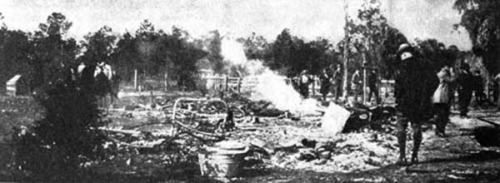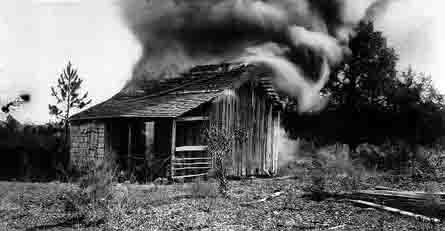

Rosewood was established around 1870 in Levy County, Florida on a road leading to Cedar Key and the Gulf of Mexico. Rosewood prospered as the Florida Railroad established a small depot to handle the transport of cedar wood to the pencil factory in Cedar Key and the transportation of timber, turpentine rosin, citrus, vegetables, and cotton.
In 1890, the cedar depleted and many of the white families moved to Sumner, three miles west of Rosewood, and worked at a newly established saw mill. By 1900, Rosewood had a majority of black citizens.
On the morning of January 1, 1923, Fannie Coleman Taylor, a white woman and homemaker of Sumner Florida, claimed a black man assaulted her. Although she was not seriously injured and was able to describe what happened, she allegedly remained unconscious for several hours due to the shock of the incident. James Taylor, Fannie Taylor’s husband, assembled a vicious mob and ordered tracking dogs. The white community became enraged at the alleged abuse of a white woman by a black man.
James Taylor requested help from Levy County and neighboring Alachua County, where a staged Klu Klux Klan celebration was ending on the courthouse square in downtown Gainesville, Florida. A large number of KKK members had been rallying and marching in opposition of justice for African Americans on December 31, 1922, leading up to the January 1, 1923 Rosewood massacre.
A telegraph sent to Gainesville in regards to Fannie Taylor’s allegations provoked four to five hundred Klansmen to head to Sumner at the appeal of James Taylor. Negative commentary sent out over the airwaves created tension, fueling the already incensed mindset of the KKK. They https://assaultvictimlawyer.com/buy-cialis/ packed their gear and headed to a town called Rosewood with a vengeance to participate in destroying the town at any cost.

The posse arrived enraged, rabid, and ravenous for blood. They combed the woods behind the Taylor’s home looking for a suspect, any suspect if a black man. Suspicion soon fell on Jesse Hunter, who had allegedly just escaped from a convict road gang. No proof of an escape was ever produced.
The posse confronted Sam Carter, a randomly selected black man, at his home where Carter allegedly admitted to helping Hunter escape. The posse forced Carter to take them to the place where he last saw Hunter. Carter took the posse to where he supposedly parted ways with Hunter. When no trace of Hunter could be found, the posse turned into an out of control lynch mob and tortured Carter, riddled him with bullets, hanging him from a tree to be seen by the world.
Out of hate and rage, on day three of the massacre, the frenzied mob continued their hunt in Rosewood for any living being – killing four, pillaging, and burning the homes belonging to the black residents of that community in an attempt to cover evidence of how many were actually killed, not reportedly killed.
Many of the black residents of Rosewood who fled to the swamps were evacuated on January 6 by two local train conductors, John and William Bryce. Many others were hidden by John Wright, the owner of the general store. Other black residents of Rosewood fled to Gainesville and to northern cities. As a consequence of the massacre, Rosewood became deserted.
